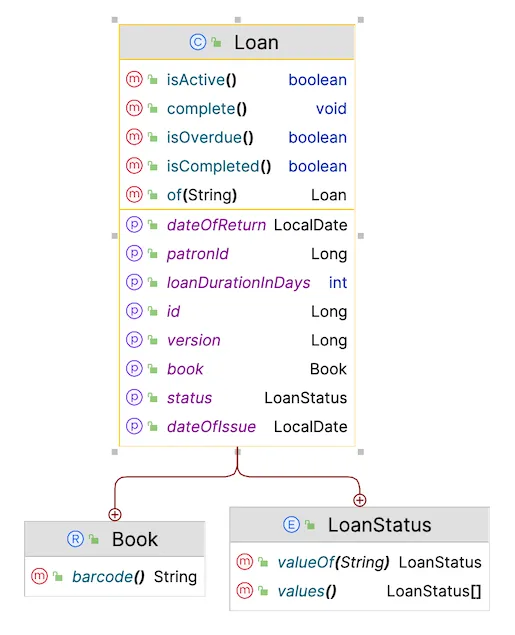Spring Modulith with DDD
Building Modular Monolith Applications with Spring Boot and Domain Driven Design
모듈
애플리케이션은 모듈로 구성됨. 각 모듈은 비즈니스 문제의 특정 부분을 해결함
모듈은 느슨하게 결합되고, 순환 의존성이 없음
모듈의 퍼블릭 인터페이스(다른 모듈에 노출되는 행위)는 유연하고 원자적으로 변경될 수 있음
마이크로서비스와 달리 모듈의 퍼블릭 인터페이스를 변경해야 할 때 해당 인터페이스를 사용하는 다른 모듈들도 함께 변경되고 배포할 수 있음
“높은 응집도, 낮은 결합도"
“함께 변경되는 것은 함께 유지되어야 함"
모듈의 경계를 패키지로 하는 경우 Controller, Service, Repository는 같은 패키지에 있어야 함
새로운 기능(aka package-by-feature)을 빌드할 때 항상 함께 변경해야 하기 때문
계층별 패키징은 정의상 응집도가 낮으므로 모듈화되지 않음
from “Structured Design”
모듈 식별하기
바운더리 식별은 여전히 중요
어떻게 바운더리 경계를 식별하나 ?
경험 상, DDD의 패턴은 이 문제를 해결하는 가장 좋은 도구임
A Business Problem - "도서관, 도서 대여 프로세스"
요구사항:
책은 바코드로 식별됨
원하는 책이 존재하는 경우 대여를 할 수 있음
고객은 책을 찾고 대여 데스크에 가서 대여함
책을 반납하기 위해서는 고객은 순환 데스크로 가거나, 드롭 존에 책을 놓아두면 됨
도서관 도메인을 서브 도메인으로 나누기
"책을 대여하는 프로세스"
"도서의 재고"
Building the Solution
2개의 Bounded Context
Borrow, Inventory 바운디드 컨텍스트를 설계하여 서브 도메인 문제를 해결함
바운디드 컨텍스트는 모듈러 모놀리스 애플리케이션의 모듈이↓기도 함
(+)가 있는 클래스만 public, 나머지는 package private
src/main/java └── example ├── borrow │ ├── Loan │ ├── LoanController │ ├── (+) LoanDto │ ├── (+) LoanManagement │ ├── LoanMapper │ ├── LoanRepository │ └── LoanWithBookDto └── inventory ├── Book ├── BookController ├── (+) BookDto ├── (+) BookManagement ├── BookMapper └── BookRepository
Inventory 바운디드 컨텍스트
Aggregate Pattern을 활용해서 Inventory 바운디드 컨텍스트를 설계
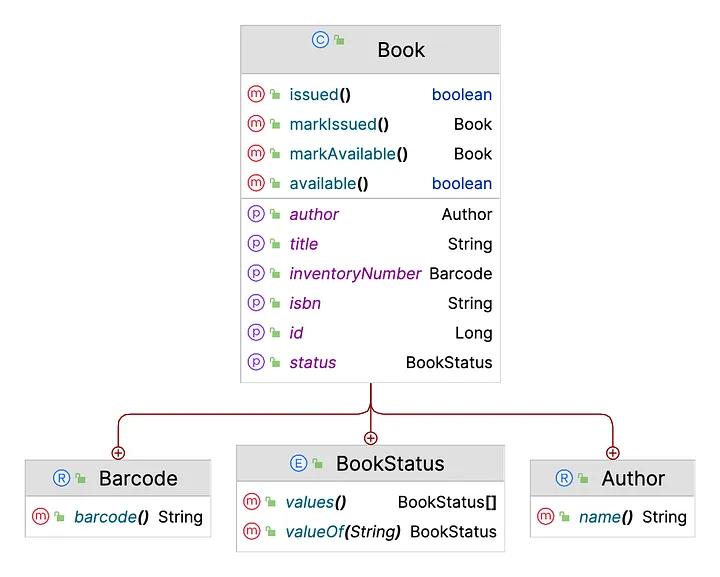
구현
Entity
Repository
Bookmanagement Service
주목할 사항
BookManagement Service는 Book 엔터티 대신 DTO를 반환함
서비스 계층에서 DTO만 반환함으로써, 도메인 모델(엔터티)가 컨트롤러나 프리젠테이션 계층으로 누출되지 않도로 보호함
BookManagement(퍼블릭 API)넌 DTO를 제외하고는 다른 모듈에서 접근 가능한 유일한 클래스임
REST API for clients
Inventory 바운디드 컨텍스트를 처음 2가지 요구사항을 완료했음
나머지 2개의 요구사항은 Borrow 바운디드 컨텍스트에 의해 구현됨
Borrow 바운디드 컨텍스트
Loan 엔터티
오래 지속되는 엔터티임
주목할 사항
book entity에 대한 foreign key 참조가 없음
대신 Book을 barcode만 갖는 value object로 모델링(
@Embedded)@Embedded @AttributeOverride(name = "barcode", column = @Column(name = "book_barcode")) private Book book; // ... public record Book(String barcode) { }메모리 참조→repository룰 통한 참조(id)
Loan과 Book 사이에는 ManyToOne JPA 관계가 없음
LoanManagement Service
주목할 점
LoanManagement 서비스가 BookManagement 서비스에 의존함
checkout, checkin의 구현이 어떠한 불변식 조사도 하지 않음
단순히 Loan 애그리것이나 Bookmanagement 서버스로 위임 (호출)만 하고, 이후에 불변식 조사가 일어남
결과적으로 매우 명확하고, 이해하기 쉬운 LoanManagement 서비스가 구현됨
BookManagement 처럼 서비스는 엔터티 대신 DTO를 반환함
몇가지 개선할 사항
바운디드 컨텍스트간 강결합
Borrow 바운디드 컨텍스트와 Inventory 바운디드 컨텍스트가 강결합됨
Inventory 바운디드 컨텍스트가 사용이 불가할 때 Borrow 바운디드 컨텍스트도 작동 불가
결제 요청은 단일 txn에서 2개의 aggregate를 갱신함
하나의 txn은 하나의 aggregate를 갱신해야 함
바운디드 컨텍스트간의 독립적인 테스트 불가
Borrow 바운디드 컨텍스트를 테스트하려면 의존성이 있는 바운디드 컨텍스트인 Inventory도 처리해야 함
checkout에 대한 테스트는 대여된 도서의 상태가
ISSUED로 갱신되었는지 확인해야 함BookManagement 서비스를 Mocking하거나 DI하지 않도고 테스트할 수 있으면 좋을 것임
@Transactional @SpringBootTest class LoanManagementIT { @Autowired LoanManagement loan; @Autowired BookManagement books; @Test void shouldCreateLoanAndIssueBookOnCheckout() { var loanDto = loans.checkout("13268510"); assertThat(loanDto.status()).isEqualTo(LoanStatus.ACTIVE); assertThat(loanDto.book().barcode()).isEqualTo("13268510"); assertThat(books.locate(1L).get().status()).hasToString("ISSUED"); } @Test void shouldCompleteLoanAndReleaseBookOnCheckin() { var loan = loans.checkin(10L); assertThat(loan.status()).isEqualTo(LoanStatus.COMPLETED); assertThat(books.locate(2L).get().status()).hasToString("AVAILABLE"); } }바운디드 컨텍스트 간의 인터페이스 제어
각 바운디드 컨텍스트는 다른 바운디드 컨텍스트에서 사용할 수 있는 특정 클래스만 노출(DTO 및 서비스 클래스)
이들은 바운디드 컨텍스트의 인터페이스 역할을 함
이를 위해서는 신중하고 지속적인 주의가 필요함
Improving Modular Monolith Applications with Spring Modulith
https://itnext.io/improving-modular-monolith-applications-with-spring-modulith-edecc787f63c
새로운 비즈니스 요구사항
고객이 도서 대여를 요청하면 바로 issued(대여됨) 상태가 됨
하지만 고객의 실제로 수령했는지 알 수 없음
따라서 보류됨(hold) 상태 추가가 필요해짐
도메인 모델을 다시 생각하기
기존의 서브도메인

기존의 동기식 강결합(tightly coupling)을 비동기식 약결합(loosely coupling)으로 변경하고자 함
강결합: 고객의 책을 대여하면 Inventory의 책 상태는 동기식으로 대여됨으로 변경됨
드러나는 새로운 서브도메인
Inventory 서브 도메인은 도서관에서 대여 가능한 모든 책을 추적하는 역할도 담당
즉 도서관의 모든 카탈로그를 관리하여 도서가 대여되고, 반납될 때 변경되는 대영 가능 여부를 추적함
실제로 2개의 서브 도메인이 하나로 모델링된 경우 어떻게 해야 할까 ?
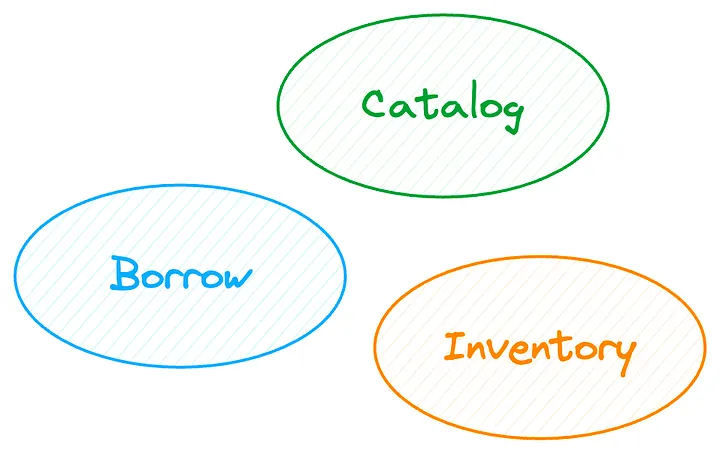
Catalog 서브도메인은 Inventory 서브 도메인이 담당할 가용성에 대한 걱정 없이 책의 메타데이터를 캡쳐하는 역할을 담당함
바운드 컨텍스트도 3개가 있어야 할까 ?
Borrow 및 Inventory 바인딩된 컨텍스트는 여전히 동일한 의존성을 공유
도메인 이벤트를 사용하여 최종적인 일관성(eventual consistency)을 가진 의존성을 모델링하면 어떨까?
도메인 이벤트를 이용해서 의존성 개선
Borrow 바운디드 컨텍스트: BookCheckoutRequested 이벤트를 발생
Inventory 바운디드 컨텍스트: 해당 이벤트를 수신하면 책이 가용한지 확인하고 BookAvailable나 BookUnavailable 이벤트 발생
Borrow 바운디드 컨텍스트: Inventory 바운디드 컨텍스트가 발생시킨 이벤트에 따라 대여 상태를 갱신(ACTIVE or REJECTED)
2개의 서브도메인, 하나의 바운디드 컨텍스트

바운디드 컨텍스트는 언어적 경계(linguistic boundary)임
모델의 의미는 바운디드 컨텍스트 내에서 변하지 않음
Borrow와 Inventory에서 도서의 의미는 동일함
Inventory 바운디드 컨텍스트에서 도서의 가장 중요한 속성은 사용 가능 상태임
Borrow 바운디드 컨텍스트에서 책을 빌리고 반납할 때 책의 사용 가능 상태가 영향을 받음
도서라는 모델은 두 바운디드 컨텍스트 간에 동일함
도서관(카탈로그)에 새 책이 추가되면 Borrow 바운디드 컨텍스트는 Inventory를 갱신하기 위해 이 사실을 알아야 함
이 이벤트를 다음과 같이 모델링 할 수 있음
Catalog 바운디드 컨텍스트
Borrow 바운디드 컨텍스트에 의해 소비되는 BookAddedToCatalog 이벤트를 발생시킴
Borrow 바운디드 컨텍스트는 지역 재고(local inventory)를 갱신하여 새로운 책을 대여할 수 있음을 나타냄
이벤트를 통해 비동기적으로 통신할 때 대여 프로세스가 더이상 카탈로그에 의존하기 않아서 Catalog 바운디드 컨텍스트와 Borrow 바운디드 컨텍스트는 느슨하게 결합됨
Borrow 바운디드 컨텍스트(with new Insights)
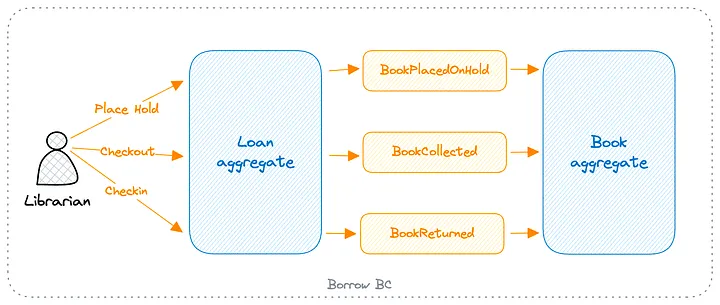
LoanManagement 서비스가 유스케이스가 실행됨에 따라 이벤트를 발생시킴
InventoryManagement 서비스는 이벤트를 리슨하고 책을 보류(hold) 상태로 만듦
@ApplicationModuleListener에 주의하라@TransactionalEventListener, @Async, @Transactional(propagation = Propagation.REQUIRES_NEW)별도의 트랜잭션에서 별도의 쓰레드로 이벤트 리스터가 동작하도록 함
리스너와 무관하게 이벤트를 트리거링하는 코드는 항상 완료됨
새로운 이슈
이벤트를 트리거한 코드이 이미 완료된 상태에서 리스너 실행이 실패되면...
Spring Modulith Event Publication Registry
spring-modulith-starter-core, spring-modulith-starter-jpa 의존성 사용
spring-modulith-starter-jpa 의존성은 이벤트 발행 레지스트리를 활성화함
EVENT_PUBLICATION 테이블을 생성함(ID, COMPLETION_DATE, EVENT_TYPE, LISTENER_ID, PUBLICATION_DATE, SERIALIZED_EVENT)
COMPLETION_DATE를 이용해서 리스너 실행이 실패하면 이벤트가 손실되지 않고 리스터 실행이 성공할 때까지 다시 트리거됨(application이 재실행될 때 재처리됨)
격리된 모듈 테스트
모듈 간이 통신에 이벤트를 도입하여 독립된 테스트가 가능해짐
@ApplicationModuleTest: 모듈을 나타내는 패키지에 대한 스프링 애플리케이션 컨텍스트만 로딩되도록 제한
스프링 모듈리스를 통한 더 강한 모듈 경계
Spring 모듈리스에서는 모든 최상위 패키지가 모듈로 간주
API 패키지라고 함
이 패키지의 모든 클래스는 다른 모듈(최상위 패키지)에서 자동으로 사용할 수 있음
최상위 패키지의 하위 패키지는 내부에 있으며 다른 모듈에서 액세스할 수 없음
이러한 제약은 아래와 같은 테스트를 통해 강화될 수 있음
모듈의 내부 클래스에 접근하면 아래와 같은 예외가 발생
모듈 문서화
스프링 모듈리스에서는 문서 스니핏과 모듈 간의 관계를 표현하는 C4 다이어그램을 생성할 수 있음
$PROJECT_ROOT/target/spring-modulith-docs 디렉토리에 산출물이 생성됨
C4 diagram of our application modules
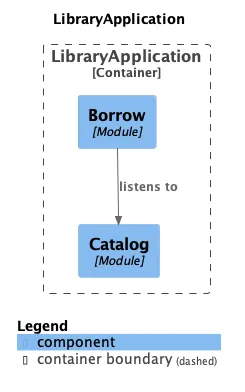
The test also generates documentation snippets for each module (bounded context).
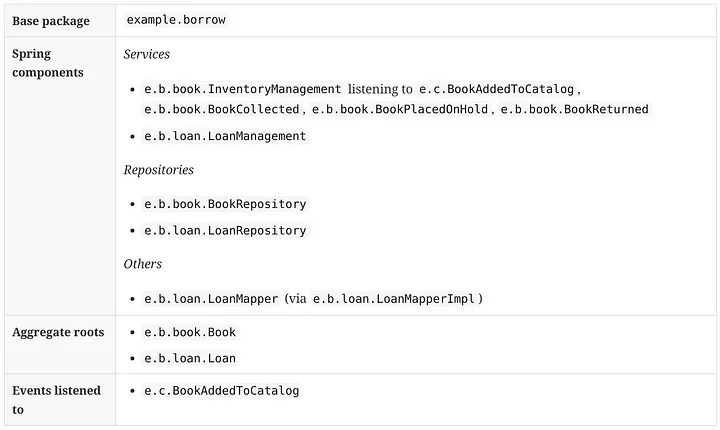
Adopting Domain-First Thinking in Modular Monolith with Hexagonal Architecture
https://github.com/xsreality/spring-modulith-with-ddd/tree/part-3-hexagonal-architecture
Spring Data Repository: Java 인터페이스로 정의되지만 동적 프록시를 통해 구현을 결합하므로 실제로는 인터페이스가 아님
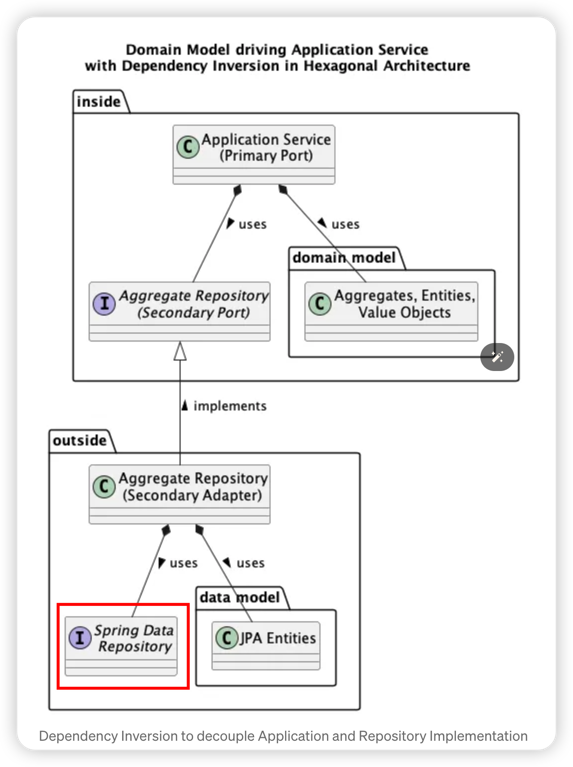
의존성을 반전시키는 데 사용되는 인터페이스는 포트, 인터페이스 구현은 어댑터
도메인 모델에 의해 구동되므로 구동형(driven) 또는 보조형(secondary)
유스 케이스를 구현하는 데 사용되는 애플리케이션 서비스도 포트
차이점은 Java 인터페이스가 아니라 일반 클래스라는 점
또한 사용 사례(REST API, GraphQL, Lambda 등)에 액세스하기 위해 기술을 결합하는 해당 어댑터도 있음
이러한 포트와 어댑터는 도메인 모델을 사용하므로 드라이버 또는 기본 이라고도 함
그들은 우리 모델의 사용을 주도함
Ports are not always interfaces and Adapters are not always implementations
Primary port can be a class while Primary Adapter uses this class
Secondary port must be an interface while Secondary adapter its implementation to inverse the dependency.
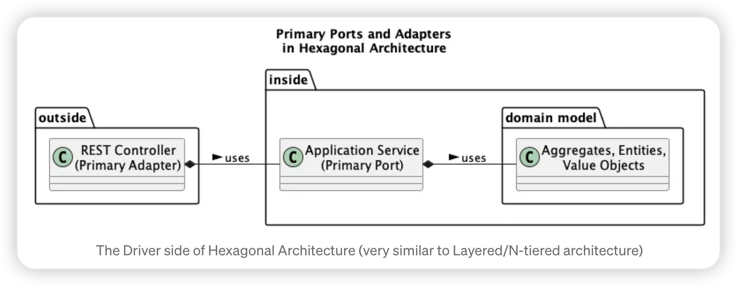
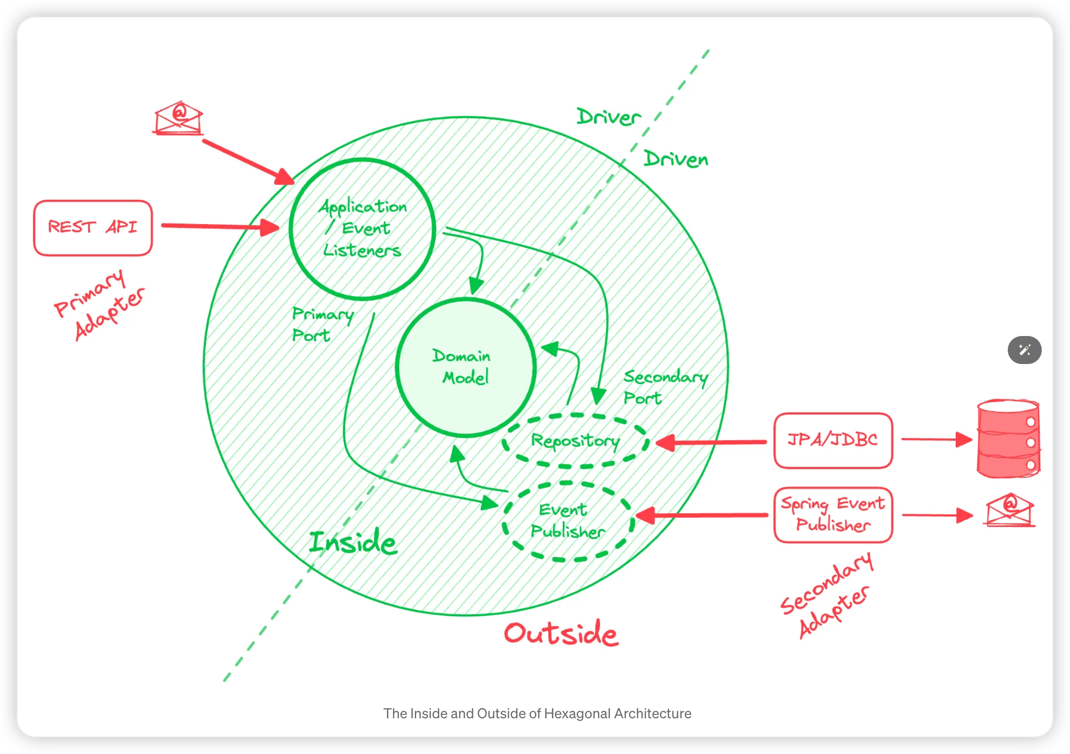
이러한 아키텍처의 장점
Core Business Logic is free of implementation details
새로운 기능 요청을 작성해야 합니까? 이를 도메인 모델에 구현하고 단위 테스트를 통해 검증합니다. Spring Boot 또는 Hibernate를 업데이트해야 합니까? 걱정하지 마세요. 도메인 모델은 영향을 받지 않습니다.
Domain Model drives the implementation
도메인 모델은 아키텍처의 핵심입니다. 다른 모든 것은 도메인 모델을 따릅니다. 이는 비즈니스 로직의 구현을 주도합니다. 이전에 구현을 주도했던 데이터 모델은 이제 지속성에만 관련된 사소한 세부 사항입니다. 기타 인프라 문제(REST API가 필요하고, 야간 점검을 수행하기 위한 스케줄러가 필요하며, AWS Lambda를 트리거해야 함)는 모두 도메인 모델과 관련이 없습니다.
Delayed Decisions
사용 사례에 Relational을 사용해야 할지, NoSQL을 사용해야 할지 잘 모르시나요? REST와 GraphQL을 사용하는 것에 대한 질문에 설계자가 돌아오지 않았나요? 이것이 비즈니스 로직 구현을 중단해서는 안 됩니다.
The Borrow Bounded Context (implemented with Hexagonal Architecture)
organize the Borrow module with below package structure
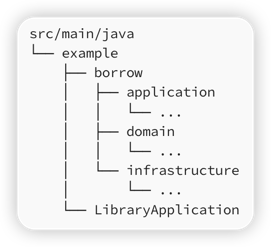
application and domain package represent the “inside” of the Hexagon while infrastructure package represents the “outside” of the Hexagon.
패키지에 관해 준수하려는 규칙
domain package
will contain the domain models (Aggregates, Entities, Value Objects) and Secondary / Driven ports that provide an interface for infrastructure to implement
We will restrict ourselves to only use standard Java, Lombok (to reduce verbose code) and JMolecules (to document stereotypes) libraries only.
application package
contain Primary / Driver ports that implement the use cases of the application
We will allow ourselves to use Spring @Transactional and Modulith @ApplicationModuleListener annotations.
infrastructure package
contain the code to build the REST APIs and JPA adapters
This is the Wild West, the outside.
No restrictions apply, all libraries are fair game here.
use case: placing hold on a book
Use Case
@PrimaryPort public class CirculationDesk { private final BookRepository books; private final HoldRepository holds; private final HoldEventPublisher eventPublisher; @Transactional public HoldDto placeHold(PlaceHold command) { books.findAvailableBook(command.inventoryNumber()) .orElseThrow(() -> new IllegalArgumentException("Book not found")); return Hold.placeHold(command) .then(holds::save) .then(eventPublisher::holdPlaced) .to(HoldDto::from); } record PlaceHold(Barcode inventoryNumber, String patronId, LocalDate dateOfHold) { } }To inverse the dependency, we introduce a Repository interface (not to be confused with Spring Data) for all Aggregates.
@SecondaryPort interface BookRepository { Optional<Book> findAvailableBook(Book.Barcode inventoryNumber); Optional<Book> findOnHoldBook(Book.Barcode inventoryNumber); Book save(Book book); Optional<Book> findByBarcode(String barcode); } @SecondaryPort interface HoldRepository { Hold save(Hold hold); Optional<Hold> findById(Hold.HoldId id); List<Hold> activeHolds(); }Triggering Domain Events from Aggregates
One outcome of a use case is to persist the updated state of the Aggregate
Another outcome can be to fire a domain event so that other modules in the monolith (or other aggregates in the same module) can react on it.
Both persisting the aggregate (using Repository) and firing an event (using Event Publisher) are secondary/driven ports in Hexagonal architecture
The implementation is irrelevant to the business logic.
An event BookPlacedOnHold is fired after the execution of our use case
This event is consumed by the Book aggregate to update the status of the book in the database
The handling of the event is the responsibility of the primary/driver port as it is core part of the business logic.
// the event publisher interface with no implementation knowledge // of how the event is actually published. @SecondaryPort public interface HoldEventPublisher { void holdPlaced(BookPlacedOnHold event); default Hold holdPlaced(Hold hold) { BookPlacedOnHold event = new BookPlacedOnHold(hold.getId().id(), hold.getOnBook().barcode(), hold.getDateOfHold()); this.holdPlaced(event); return hold; } } // the event handler using Spring Modulith listener // to reliably react to the event. @PrimaryPort class CirculationDeskEventHandler { private final BookRepository books; private final HoldEventPublisher eventPublisher; @ApplicationModuleListener public void handle(BookPlacedOnHold event) { books.findAvailableBook(new Book.Barcode(event.inventoryNumber())) .map(Book::markOnHold) .map(books::save) .orElseThrow(() -> new IllegalArgumentException("Duplicate hold?")); } }
Unit Testing the “Inside” (Business Logic) in Hexagonal
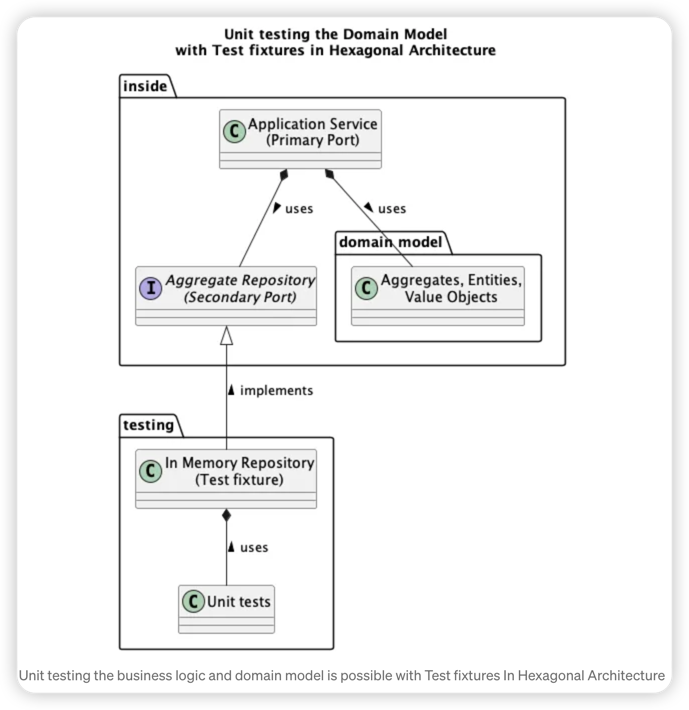
A big advantage of implementing business logic without framework dependencies
able to unit test the code without needing integration tests.A big advantage of implementing business logic without framework dependencies is to be able to unit test the code without needing integration tests.
class CirculationDeskTest { CirculationDesk circulationDesk; // Application Service BookRepository bookRepository; // Secondary Port HoldRepository holdRepository; // Secondary Port @BeforeEach void setUp() { bookRepository = new InMemoryBooks(); holdRepository = new InMemoryHolds(); circulationDesk = new CirculationDesk(bookRepository, holdRepository, new InMemoryHoldsEventPublisher()); } @Test void patronCanPlaceHold() { var command = new Hold.PlaceHold(new Book.Barcode("12345"), LocalDate.now()); var holdDto = circulationDesk.placeHold(command); assertThat(holdDto.getBookBarcode()).isEqualTo("12345"); assertThat(holdDto.getDateOfHold()).isNotNull(); } @Test void bookStatusUpdatedWhenPlacedOnHold() { var command = new Hold.PlaceHold(new Book.Barcode("12345"), LocalDate.now()); var hold = Hold.placeHold(command); circulationDesk.handle(new BookPlacedOnHold(hold.getId().id(), hold.getOnBook().barcode(), hold.getDateOfHold())); //noinspection OptionalGetWithoutIsPresent var book = bookRepository.findByBarcode("12345").get(); assertThat(book.getStatus()).isEqualTo(ON_HOLD); } } // Test Fixture (acts as Secondary Adapter implementing the Secondary Port) class InMemoryBooks implements BookRepository { private final Map<String, Book> books = new HashMap<>(); public InMemoryBooks() { var booksToAdd = List.of( Book.addBook(new Book.AddBook(new Book.Barcode("12345"), "A famous book", "92972947199")), Book.addBook(new Book.AddBook(new Book.Barcode("98765"), "Another famous book", "98137674132")) ); booksToAdd.forEach(book -> books.put(book.getInventoryNumber().barcode(), book)); } ... } // Test Fixture (acts as Secondary Adapter implementing the Secondary Port) class InMemoryHolds implements HoldRepository { // similar to InMemoryBooks above ... }Since our domain model is relying on an interface for persisting the aggregate or triggering an event, the unit test needs a test fixture to be able to execute the interface methods. An implementation for every Secondary/Driven ports is required for the unit tests to work.
Unit Testing the Architecture rules
@AnalyzeClasses(packages = "example.catalog") public class CatalogJMoleculesTests { @ArchTest ArchRule dddRules = JMoleculesDddRules.all(); @ArchTest ArchRule layering = JMoleculesArchitectureRules.ensureLayering(); } @AnalyzeClasses(packages = "example.borrow") public class BorrowJMoleculesTests { @ArchTest ArchRule dddRules = JMoleculesDddRules.all(); @ArchTest ArchRule hexagonal = JMoleculesArchitectureRules.ensureHexagonal(); }Integration Testing the “Outside” in Hexagonal
The outside where technologies interface with our domain model should be tested with Integration test to verify their behaviour
// from CirculationDeskIT @Test void patronCanPlaceHold(Scenario scenario) { var command = new Hold.PlaceHold(new Book.Barcode("13268510"), LocalDate.now()); scenario.stimulate(() -> circulationDesk.placeHold(command)) .andWaitForEventOfType(BookPlacedOnHold.class) .toArriveAndVerify((event, dto) -> { assertThat(event.inventoryNumber()).isEqualTo("13268510"); }); } // from CirculationDeskControllerIT @Test void placeHoldRestCall() throws Exception { mockMvc.perform(post("/borrow/holds") .contentType(MediaType.APPLICATION_JSON) .content(""" { "barcode": "64321704", "patronId": 5 } """)) .andExpect(status().isOk()); }Visualizing Class Stereotypes with jMolecules
Avoid Purist implementations of Hexagonal architecture
Hexagon 내부는 핵심 비즈니스 로직 구현으로 육각형 외부에서 사용되는 프레임워크와 기술이 없어야 합니다.
나는 이 규칙을 종교적으로 따르려고 시도하여 프레임워크와 싸우는 복잡한 코드로 이어지는 일부 구현을 보았습니다.
Merging detached JPA entities built from Domain model
The holds::save is a call on the Secondary port interface which will trigger the Secondary adapter implementation:
Code
도메인 객체 생성에 필요한 커맨드를 해당 도메인 객체에 innner record로 정의
dto#from(domainModel) factory method가 존재
persistence entity와 domain model 분리
Adapter가 Jpa Repository Interface를 사용
도메인 객체를 fluent하게 사용하기 위한 헬퍼 함수
전통적인 Hexagonal과 비교
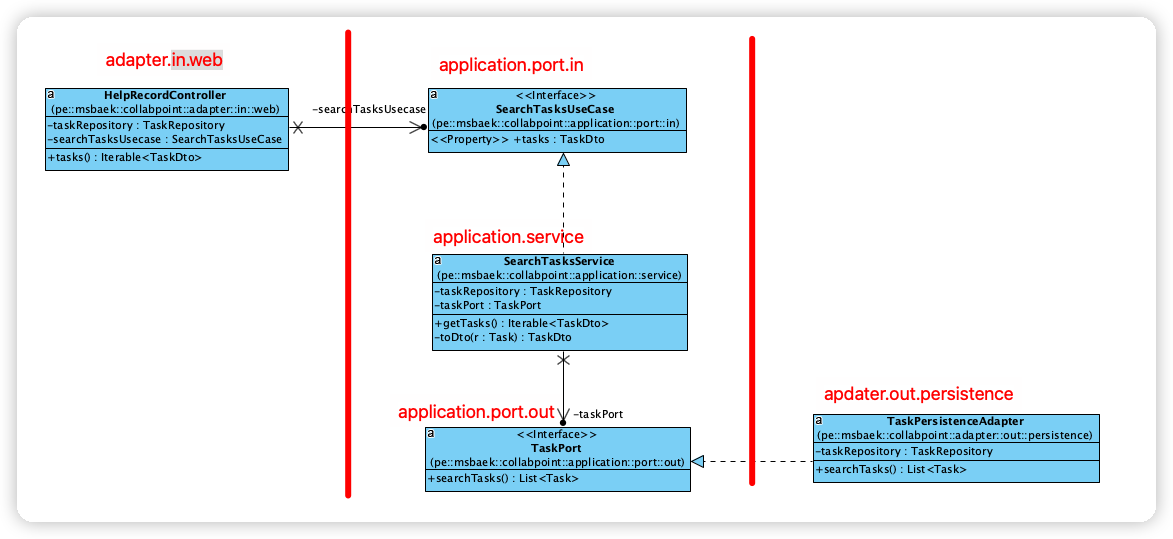
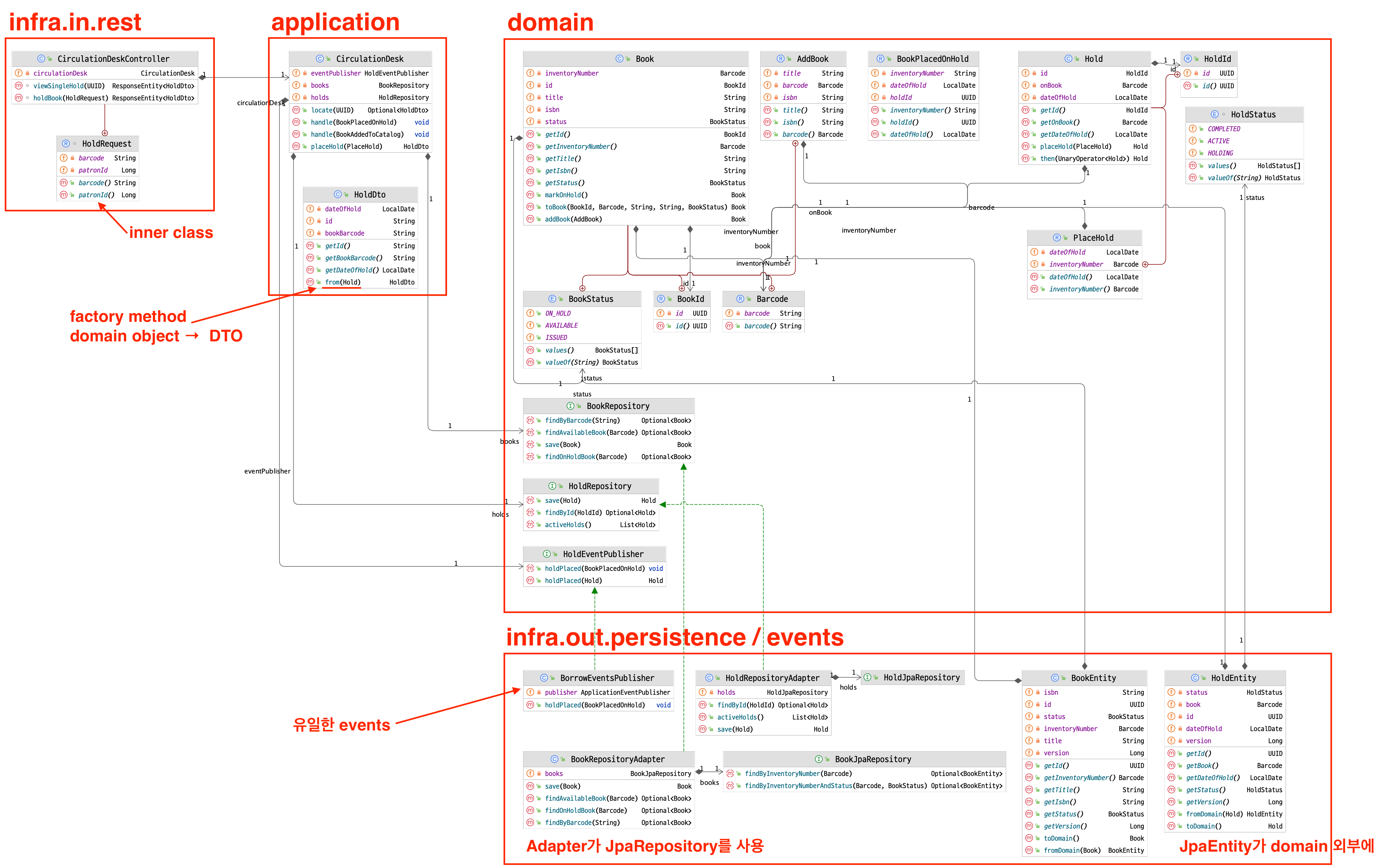
issues
entity를 adapter에
이래서 단위 테스트가 순수해 졌음
entity <-> model 어떻게 하나 ?
lazy loading, dirty check ?
optimistic locking은 ?
메모
테이블에 constraint 걸기
@Table(uniqueConstraints = @UniqueConstraint(columnNames = {"barcode"}))Entity의 속성을 Value Object로 매핑하기
aggregate root
애그리것에 대한 모든 변경(예: 도서의 상태 수정)은 Book 엔티티를 통해서만 이루어져야 하고, 모듈 자체로 제한되어야 함
상태 변경을 유발하는 메소드의 이름 명명 규칙(markXXX)
Book::markIssued: 대여됨으로 상태 변경Book::markAvailable: 대여 가능 상태로 변경
Bounded Context > Sub domains > application + domain + ui
하나의 바운디드 컨텍스는 1개 이상의 서브 도메인을 가질 수 있음
바운디드 컨텍스트가 모듈이고 배포의 단위인 듯
서브 도메인은 application, infra, domain, ui 등의 패키지를 가질 수 있음
Provided Interface
다른 모듈에 노출되는 API
스프링 빈이나 모듈에 의해 발행되는 애플리케이션 이벤트에 의해 구현
Required Interfaces
스프링 빈, 애플리케이션 이벤트의 형태로 다른 모듈이 노출하는 API에 대한 참조
spring modulith의 패키지들
메인 패키지: @SpringBootApplication으로 어노테이션된 클래스가 있는 패키지
애플리케이션 모듈 패키지: 메인 패키지의 하위 패키지
API 패키지 = 애플리케이션 모듈 패키지 ← → internal 패키지
발행된 이벤트 재처리
완료되지 않은 이벤트는 애플리케이션 재시작 시 재처리됨
완료되지 않은 이벤트를 일정 시간 후에 재처리 하는 것도 가능
또, 완료된 이벤트를 DB에서 제거하거나 아카이브 저장소로 이동도 가능
CompletedEventPublications
이 인터페이스는 완료된 모든 이벤트 발행물에 액세스할 수 있으며, 데이터베이스에서 모든 발행물을 즉시 제거하거나 지정된 기간(예: 1분)보다 오래된 완료된 발행물을 제거하기 위한 API를 제공
IncompleteEventPublications
이 인터페이스는 모든 완료되지 않은 이벤트 발행물에 액세스하여 지정된 조건과 일치하거나 원래 발행 날짜를 기준으로 지정된 기간보다 오래된 발행물을 다시 제출할 수 있도록 함
이벤트 발행 로그 활성화
EventPublicationRepository(spring-modulith-starter-jpa)가 제공됨
spring.modulith.events.jdbc-schema-initialization.enabled=true
Externalizing Events
Kafka, AMQP, JMS, SQS, SNS
Bootstrap Modes
STANDALONE(default): Runs the current module only.
DIRECT_DEPENDENCIES: Runs the current module as well as all modules the current one directly depends on.
ALL_DEPENDENCIES: Runs the current module and the entire tree of modules depended on.
